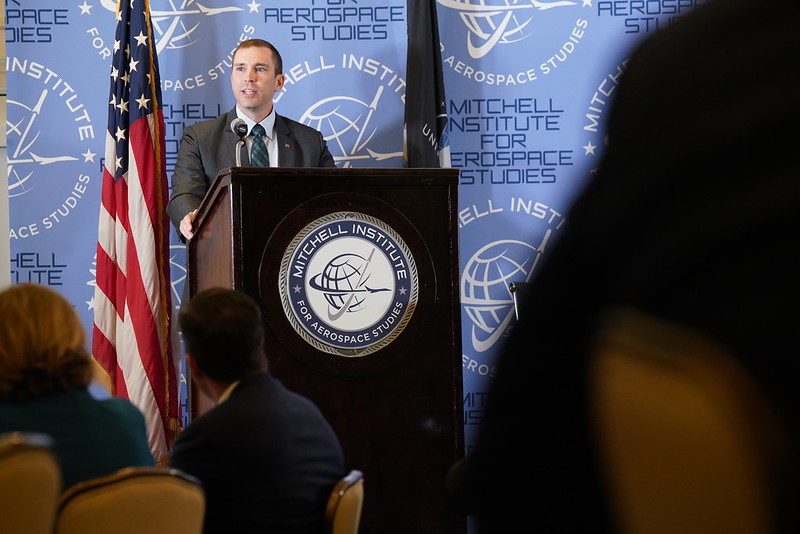Some of the satellites that will form the planned “backbone” of joint all-domain command and control may include “translation” payloads to let other satellites feed their data into the Pentagon’s massive mesh network, the head of the Space Development Agency said Oct. 25.
SDA is still committed to establishing common standards for networking and communications on the planned National Defense Space Architecture, director Derek M. Tournear said at the Mitchell Institute’s Spacepower Security Forum. Of particular importance will be the Transport Layer, which will be responsible for providing data and connectivity to countless platforms across the U.S. military.
That ability to link sensors and shooters across the globe is what will make the Transport Layer a key component of joint all-domain command and control, the Pentagon’s ambitious effort to create a military Internet of Things, Tournear said.
But while common standards will be crucial to avoiding “vendor lock” and allowing different contractors to compete for Transport Layer contracts, Tournear suggested that SDA will also look to incorporate other satellite systems, both government and industry, into the data network via “translator sats.”
“A translator sat is a satellite that will be able to basically talk to the SDA Transport Layer and talk to either the commercial or other government agency providers’ layer so we can do that translation to move data from one network onto the other,” Tournear said. “And there’s a lot of reasons you may need to do that. … While not the preferred, that’s another option that we have available to be able to use the SDA Transport layer to tie this whole mission together. The whole mission, in a nutshell, is to get the right sensor data to the right shooter at the right time. And that’s how we enable that.”
Tournear later clarified that such a “translator” likely wouldn’t be a dedicated satellite, but instead a payload, either on a satellite launched as part of the NDSA, or as part of another satellite architecture.
SDA is already “working with our partners” on the translator concept, Tournear added.
Such a capability may be necessary even as SDA has looked to establish common standards. For networking, it is asking contractors to follow standards established by the Naval Research Laboratory’s Space Research Group called Nebula—which stands for “networking beyond the upper limits of the atmosphere.” It also has adopted optical communications standards, “to make sure that my walkie talkie talks to their walkie talkie,” Tournear said.
“We actually have with [the Naval Research Lab], we have developed a test lab so that folks can bring their optical terminals to NRL to demonstrate that they can plug and play with our optical standard, as well as other vendors’ optical communication terminals, to make sure there is no vendor lock situation and it’s all interoperable,” Tournear added.
Yet even with those standards, satellite constellations are already in orbit that may not have the necessary equipment. And there are other reasons why a contractor or agency might not meet the standards.
“You have some of the commercial networks up there and some of the commercial ISR data providers, they may not have either the capability or the ability to put an optical comms terminal that matches the SDA Transport Layer, or, frankly, they may not be able to meet the Nebula standards because of crypto requirements and things like that, which is not an easy thing to solve,” Tournear said.
That’s where the translation payloads come in, but three technical challenges have to be addressed, Tournear said.
First, the vendor running the satellite architecture would need to launch at least one satellite with an optical communications terminal to link up with SDA’s Transport Layer. Then, “what you need is a Nebulizer and a de-Nebulizer,” Tournear said—a way to take networking protocols and put them into SDA’s Nebula standard format so that data can be shared.
“We’re developing generic … software development toolkits for the Nebulizer and the De-Nebulizer that then third-party vendors could take, and they can use that as a starting point and to integrate that in with their system,” Tournear said.
Finally, the vendor and SDA will need to work out cybersecurity issues to ensure that the data being passed is safe, but “that’s something that has a lot of different types of solutions,” Tournear said.
As SDA works on those problems, “translator sats” won’t be part of the agency’s very first launches, scheduled for the coming months. But Tournear hinted that they could be in orbit in the coming years, starting with the planned Tranche 2 Demonstration and Experimentation Satellites, or T2DES.
“This isn’t set in stone, but likely some of those satellites would be demonstrators of different translator sats for different constellations,” Tournear said. “So those would be in your [2026] timeframe.”
